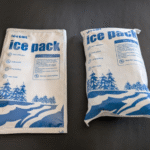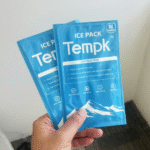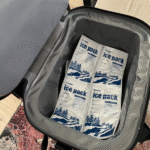هل هناك رائحة أو تراكم غاز في أكياس ثلج جافة?
عندما تحزم البضائع المجمدة بالثلج الجاف, you might worry about strange smells or dangerous gases. The good news is that dry ice itself is odorless, but it does release carbon dioxide (co₂) gas as it sublimates. Without proper ventilation this gas can build up in the bag and become hazardous. This guide explains why dry ice has no smell, how gas build up occurs, and what you can do to prevent accidents while preserving product quality.

Why dry ice is odorless and why any scent you notice likely comes from packaging materials rather than the dry ice itself.
How CO₂ gas builds up داخل أكياس الثلج الجاف and the dangers of pressure and suffocation if packages are airtight.
Safe handling guidelines for venting, معدات الحماية, تخزين, and transportation to prevent gas build up.
Key regulations and best practices from shipping carriers and safety agencies to comply with 2025 المعايير.
الأسئلة الشائعة about smell, الغاز, and safety answered concisely to address user concerns.
What causes gas build-up in dry ice bags?
Dry ice is solid carbon dioxide that sublimates directly into CO₂ gas. When dry ice is sealed inside a bag, the gas accumulates and increases pressure. This can cause the bag or outer container to rupture if there’s no venting. Venting allows the gas to escape safely while maintaining cold temperatures.
Ventilation is essential because CO₂ gas is heavier than air. In confined spaces it can displace oxygen and create an asphyxiation hazard. A one pound block of dry ice releases about 250 liters of CO₂ gas during sublimation. If enough gas builds up in a small area, oxygen levels can fall below the safe threshold of 19.5%, causing dizziness, الصداع, or unconsciousness.
Understanding sublimation and pressure
يتسامى الثلج الجاف عند -78.5 درجة مئوية (-109.3 ° f). During shipment the rate of sublimation depends on insulation, درجة الحرارة المحيطة, ومقدار الجليد الجاف المستخدم. Typical sublimation rates range from 5–10 pounds per 24 ساعات. As each pound sublimates, it produces enough CO₂ gas to inflate several 55 gallon drums. If the gas cannot escape, the pressure can grow until the container bursts.
| عامل | Effect on gas build up | ماذا يعني لك |
| Amount of dry ice | More dry ice releases more gas as it sublimates. | Use only the amount needed for the transit window. A dry ice mass calculator can help determine appropriate weight. |
| Insulation level | Thick insulation slows sublimation and reduces gas flow; poor insulation speeds sublimation and gas release. | Choose a well insulated liner like foam or foil lined bags to slow gas release while still venting it safely. |
| Container seal | Airtight seals trap CO₂, increasing pressure. Venting allows gas to escape. | Always ensure your dry ice bag or liner has a venting mechanism and leave the outer box slightly cracked. |
| درجة الحرارة المحيطة | Warmer surroundings speed sublimation, releasing gas faster. | Pre cool containers and avoid exposing shipments to heat to manage gas build up. |
Why proper ventilation is critical
Gas build up isn’t just about pressure—it’s also about safety. CO₂ is colorless and odorless, so you won’t smell or see it accumulating. In unventilated spaces, CO₂ displaces oxygen and can lead to headaches, increased heart rate, and dizziness. At high concentrations, it can cause unconsciousness and even death. That’s why most carriers and regulatory bodies require packages containing dry ice to be vented and labeled with “Carbon dioxide, solid” and the net weight of dry ice.
Ventilate by using a dry ice bag designed with a vented closure (fold and clamp, band and fold, or micro perforated film). Never seal the bag completely or tape over the vents. Leave a small gap in the outer cooler lid or use a container with vent plugs so gas can escape. عند نقل الثلج الجاف في السيارة, keep windows open to allow fresh air circulation.
Practical tips for preventing gas build up
Use vented bags or liners: Many dry ice bags have built in vent systems, such as micro perforations or fold and clamp closures, that release gas without losing ice pellets.
Leave headspace: Don’t overfill containers. Leave room for gas expansion and avoid stuffing the bag to capacity.
تجنب أختام محكمة الإغلاق: Use a cooler or box with a loose fitting lid or vent plug. Do not tape the lid shut or shrink wrap it tightly around the bag.
قم بتبريد الحاوية الخاصة بك مسبقًا: Chilling the cooler before adding dry ice slows sublimation, reducing the rate of gas production.
Monitor environmental conditions: Keep shipments away from heat sources and avoid storing dry ice in walk in freezers or cold rooms with no ventilation.
دراسة حالة: A meal kit company reduced rejected shipments and customer complaints by switching from sealed plastic bags to vented dry ice liners. By leaving the outer cooler lid slightly open and using micro perforated film vents, they saw a significant drop in pressure related packaging failures. This simple change improved safety and product quality while meeting carrier acceptance criteria.
Does dry ice have a smell?
No—dry ice is odorless. Carbon dioxide gas has no smell, ذوق, or color. In everyday shipments you should not detect any scent from the dry ice itself. If you notice a strange odor inside the package, it usually comes from other sources:
مواد التعبئة والتغليف: رقائق, بلاستيك, مواد لاصقة, or dyes can off gas faint smells when exposed to extreme cold.
Product aromas: Foods like seafood or cheese may release scents as they thaw slightly during transit.
Contaminants: Reused containers may carry residual odors from previous shipments.
It’s important to understand that because CO₂ is odorless, you cannot rely on smell to detect gas build up. You must always vent containers and follow safety guidelines even if there is no scent.
مقارنة: الجليد الجاف مقابل. other refrigerants
Dry ice isn’t the only option for shipping perishables. حزم هلام, wet ice, and phase change materials each have advantages and disadvantages. Here’s a quick comparison of how these cooling methods perform in terms of smell and gas production:
| المبرد | Odor | Gas build up risk | مدة | الآثار العملية |
| الجليد الجاف | Odorless | High if not vented | طويل (24-96 ساعة) | Must vent to prevent pressure; extremely cold; لا بقايا سائلة. |
| حزم هلام | Slight chemical scent depending on formulation | الحد الأدنى, but may leak liquid | واسطة (12-48 ساعة) | Suitable for refrigerated temps; no venting needed; أسهل في التعامل معها. |
| الجليد الرطب | Might carry chlorinated water smell | لا أحد (يذوب في الماء) | قصير (6-24 ساعة) | Creates liquid mess; خطر التلوث; requires waterproof packaging. |
| مواد تغيير المرحلة (PCMS) | Usually odorless | قليل | عامل (8-72 ساعة) | Maintains specific temperature range; good for vaccines or pharmaceuticals; تكلفة أعلى. |
How to tell if the gas level is too high
Since you can’t smell CO₂, use these methods to assess ventilation and gas levels:
Look for fogging or condensation: Excess gas inside a bag may cause condensation when it escapes through vents. If the bag feels very firm or bulging, gas pressure may be high.
Check vent outlets: Ensure vents aren’t blocked by plastic wrap or other materials. A slight hiss or gentle airflow indicates gas is escaping.
Use CO₂ monitors: In storage areas or vehicles where large amounts of dry ice are used, portable CO₂ sensors can alert you if gas levels exceed safety limits. Keep levels below 5,000 ppm for an 8 hour time weighted average and below 30,000 ppm for short term exposure.
How to pack dry ice bags safely to avoid gas hazards
Step-by-step packing guidelines
حساب كمية الثلج الجاف: Determine how long your shipment needs to stay cold and use a dry ice mass estimator. كقاعدة عامة, 5–10 pounds of dry ice keep contents frozen for 24 ساعات; increase weight for longer transit.
Choose a vented dry ice bag: Select a bag designed for dry ice with built in venting mechanisms. Options include fold and clamp bags, zip seal bags with vent slits, or micro perforated films.
قم بتهيئة الحاوية الخاصة بك مسبقًا: Chill the cooler or insulated box before packing to minimize thermal shock and slow sublimation.
Layer dry ice and products: Place a layer of dry ice at the bottom of the bag. Use cardboard or foam separators to prevent direct contact with food or sensitive itemsups.com.
Seal the dry ice bag loosely: Close the bag using its vent system. Fold and secure the closure with clips or straps; do not tape the bag shut or block vent holes.
Place bag in outer container: Insert the vented bag into an insulated cooler or shipping box. Leave a small gap or use vent plugs to allow gas to escape from the outer container.
قم بتسمية الشحنة: Mark the outer box with “Carbon dioxide, solid” and the UN 1845 identifier. Include the net weight of dry ice and ensure that hazard labels are visible.
Store and transport properly: Keep the package in a cool, منطقة جيدة التهوية. عند النقل بالسيارة, crack windows and avoid storing the package in the passenger compartment for long periods.
Best practices for storage and handling
معدات الحماية الشخصية (PPE): ارتد قفازات معزولة ونظارات واقية عند التعامل مع الثلج الجاف لمنع قضمة الصقيع.
Never store dry ice in airtight fridges or freezers: The extreme cold can damage equipment and cause dangerous pressure build up.
Avoid overstocking in confined spaces: Large amounts of dry ice in small rooms can raise CO₂ levels quickly. Use CO₂ sensors and ensure mechanical ventilation when storing more than 25 جنيه.
تخلص من الثلج الجاف بأمان: Let leftover dry ice sublimate outdoors or in a well ventilated area. لا ترميها في سلة المهملات أو في الحوض.
Regulations and guidelines for 2025 وما وراءها
متطلبات الناقل
Major carriers follow the International Air Transport Association (IATA) Dangerous Goods Regulations and national standards. تشمل المتطلبات الرئيسية:
حدود الوزن: تسمح الخطوط الجوية عادةً بما يصل إلى 200 كجم (تقريبًا 440 رطل) of dry ice per package for cargo aircraft; passenger aircraft have lower limits (على سبيل المثال, 5.5 lbs for personal travel).
وضع العلامات: يجب أن تعرض الحزم الأمم المتحدة 1845 ملصق, the proper shipping name “Carbon dioxide, صلب,” and the net weight of dry ice.
التغليف: Carriers require leak proof inner bags and insulated outer containers that permit gas release without sealing all seams.
التوثيق: Some shipments require a Dangerous Goods Declaration; others (when only dry ice is included) may be excepted but still need proper labeling and training.
OSHA and EHS guidelines
Occupational exposure limits: Maintain CO₂ concentrations below 5,000 ppm over an 8 hour exposure and below 30,000 ppm for short durations.
تهوية: Work in well ventilated areas and never store dry ice in small enclosed spaces or walk in freezers.
Training requirements: Individuals preparing or shipping dry ice must complete hazardous materials training and certification as required by law.
Advances and trends for 2025
العبوة الذكية: Shippers are integrating temperature and CO₂ sensors into dry ice bags to monitor gas levels in real time. These sensors alert handlers when venting is inadequate, reducing spoilage and safety incidents.
مواد قابلة للتحلل: New vented liners made from plant based foams and recycled materials offer improved insulation while reducing environmental impact. They still maintain necessary gas release pathways.
التبريد الهجين: Combining dry ice with phase change materials or gel packs extends duration and controls temperature fluctuations. Hybrid systems can reduce the amount of dry ice needed, thereby lowering CO₂ gas generation.
الوضوح التنظيمي: Agencies like the FAA and OSHA continue to refine guidelines, emphasizing venting, وضع العلامات, والتدريب. Expect more digital tools for calculating safe dry ice quantities and generating compliance documentation.
الأسئلة الشائعة: Quick answers to common questions
س 1: Can I smell if CO₂ is leaking from a dry ice bag?
لا. Carbon dioxide is odorless and colorless. You cannot detect a leak by smell. Use proper ventilation and avoid relying on your senses to determine gas levels.
Q2: Why does my dry ice shipment have a strange odor?
Any smell likely comes from packaging materials or the items being shipped. Adhesive glues, dyes, or the food products themselves may off gas at low temperatures. Dry ice does not produce an odor.
س 3: What happens if I seal a dry ice bag completely?
Sealing a dry ice bag traps gas, causing pressure to build and potentially rupture the bag or outer container. Always use vented bags and allow gas to escape.
س 4: How much dry ice can I use for air travel?
Airlines limit passengers to about 5.5 pounds of dry ice in carry on or checked luggage and require vented packaging and labeling. الشحنات التجارية قد تحمل ما يصل إلى 200 kg per package depending on the airline and cargo aircraft.
س 5: Is carbon dioxide gas from dry ice dangerous?
At high concentrations, CO₂ can displace oxygen and cause headaches, dizziness, and suffocation. Always vent containers and ensure good airflow. Keep CO₂ levels below occupational exposure limits (5,000 ppm for long term exposure).
س6: Can I reuse a dry ice bag that once held fish or meat?
Reusing bags is possible, but thoroughly clean and air them out to remove any odors from previous contents. Make sure the vent system still functions properly. Replace bags that are damaged or have compromised vents.
س7: Do foil lined bags reduce gas build up?
Foil lined bags improve insulation by reflecting radiant heat and slowing sublimation. لكن, they still need venting. A foil lining without vent openings can increase pressure; always ensure the bag has a vented closure.
ملخص وتوصيات
Dry ice is a powerful cooling agent that keeps shipments frozen for long periods, but it does come with unique challenges. There is no smell associated with dry ice itself because carbon dioxide gas is odorless and colorless. Gas build up occurs when dry ice sublimates in an enclosed space, creating pressure and displacing oxygen. To prevent accidents and ensure product quality:
Use vented bags and leave a small gap in outer containers.
تعامل مع الثلج الجاف بالقفازات المعزولة وحماية العين.
Store and ship in well ventilated areas; avoid airtight freezers or confined spaces.
Follow carrier rules for labeling, حدود الوزن, والتوثيق.
Consider smart packaging and hybrid cooling methods to improve safety and efficiency.
By respecting these principles, you’ll protect your goods and everyone involved in the cold chain.
الروابط الداخلية الموصى بها
How to pack dry ice to ship frozen meat safely – Explore step by step packing methods and safety tips for shipping frozen meats.
How to use dry ice packs – Learn how gel packs and dry ice work together to keep products cold without freezing them.
Is a foil lined bag better for dry ice? – Compare different insulations like foil and foam to find the best option for your shipment.
Dry ice bag zip seal safety guide – Understand vent designs and how to select the right bag for long transit.
Cold chain sustainability trends – Discover how biodegradable materials and smart sensors are shaping the future of cold shipping.
These resources deepen your understanding and help you make informed decisions about cold chain logistics.
حول Tempk
Tempk هي شركة رائدة في حلول التعبئة والتغليف لسلسلة التبريد, offering a full range of أكياس ثلج جافة متهمة, foil lined liners, and reusable gel packs. We combine industry expertise with cutting edge materials to ensure your perishable goods arrive safely and sustainably. Our commitment to research and innovation means our products are up to date with the latest 2025 regulations and sustainability trends. Partner with us to enhance your shipping strategy and protect your reputation.
دعوة إلى العمل: Ready to improve your cold chain performance? تواصل مع المتخصصين لدينا to find the right vented bag or hybrid cooling solution for your next shipment.























